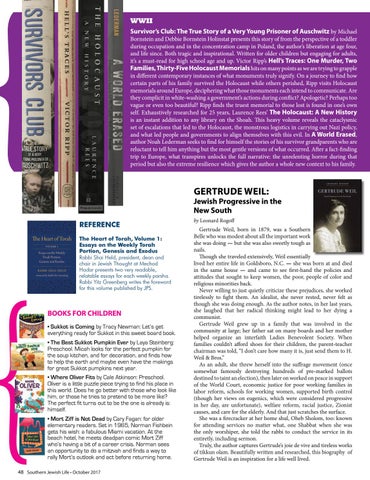{
{
WWII Survivor’s Club: The True Story of a Very Young Prisoner of Auschwitz by Michael Bornstein and Debbie Bornstein Holinstat presents this story of from the perspective of a toddler during occupation and in the concentration camp in Poland, the author’s liberation at age four, and life since. Both tragic and inspirational. Written for older children but engaging for adults, it’s a must-read for high school age and up. Victor Ripp’s Hell’s Traces: One Murder, Two Families, Thirty-Five Holocaust Memorials hits on many points as we are trying to grapple in different contemporary instances of what monuments truly signify. On a journey to find how certain parts of his family survived the Holocaust while others perished, Ripp visits Holocaust memorials around Europe, deciphering what those monuments each intend to communicate. Are they complicit in white-washing a government’s actions during conflict? Apologetic? Perhaps too vague or even too beautiful? Ripp finds the truest memorial to those lost is found in one’s own self. Exhaustively researched for 25 years, Laurence Rees’ The Holocaust: A New History is an instant addition to any library on the Shoah. This heavy volume reveals the cataclysmic set of escalations that led to the Holocaust, the monstrous logistics in carrying out Nazi policy, and what led people and governments to align themselves with this evil. In A World Erased, author Noah Lederman seeks to find for himself the stories of his survivor grandparents who are reluctant to tell him anything but the most gentle versions of what occurred. After a fact-finding trip to Europe, what transpires unlocks the full narrative: the unrelenting horror during that period but also the extreme resilience which gives the author a whole new context to his family.
GERTRUDE WEIL:
Jewish Progressive in the New South REFERENCE The Heart of Torah, Volume 1: Essays on the Weekly Torah Portion, Genesis and Exodus Rabbi Shai Held, president, dean and chair in Jewish Thought at Mechod Hadar presents two very readable, relatable essays for each weekly parsha. Rabbi Yitz Greenberg writes the foreword for this volume published by JPS.
BOOKS FOR CHILDREN • Sukkot is Coming by Tracy Newman: Let’s get everything ready for Sukkot in this sweet board book. • The Best Sukkot Pumpkin Ever by Laya Steinberg: Preschool. Micah looks for the perfect pumpkin for the soup kitchen, and for decoration, and finds how to help the earth and maybe even have the makings for great Sukkot pumpkins next year. • Where Oliver Fits by Cale Atkinson: Preschool. Oliver is a little puzzle piece trying to find his place in this world. Does he go better with those who look like him, or those he tries to pretend to be more like? The perfect fit turns out to be the one is already is: himself. • Mort Ziff is Not Dead by Cary Fagan: for older elementary readers. Set in 1965, Norman Fishbein gets his wish: a fabulous Miami vacation. At the beach hotel, he meets deadpan comic Mort Ziff who’s having a bit of a career crisis. Norman sees an opportunity to do a mitzvah and finds a way to rally Mort’s outlook and act before returning home.
48 Southern Jewish Life • October 2017
by Leonard Rogoff
Gertrude Weil, born in 1879, was a Southern Belle who was modest about all the important work she was doing — but she was also sweetly tough as nails. Though she traveled extensively, Weil essentially lived her entire life in Goldsboro, N.C. — she was born at and died in the same house — and came to see first-hand the policies and attitudes that sought to keep women, the poor, people of color and religious minorities back. Never willing to just quietly criticize these prejudices, she worked tirelessly to fight them. An idealist, she never rested, never felt as though she was doing enough. As the author notes, in her last years, she laughed that her radical thinking might lead to her dying a communist. Gertrude Weil grew up in a family that was involved in the community at large; her father sat on many boards and her mother helped organize an interfaith Ladies Benevolent Society. When families couldn’t afford shoes for their children, the parent-teacher chairman was told, “I don’t care how many it is, just send them to H. Weil & Bros.” As an adult, she threw herself into the suffrage movement (once somewhat famously destroying hundreds of pre-marked ballots destined to taint an election), then later on worked on peace in support of the World Court, economic justice for poor working families in labor reform, schools for working women, supported birth control (though her views on eugenics, which were considered progressive in her day, are unfortunate), welfare reform, racial justice, Zionist causes, and care for the elderly. And that just scratches the surface. She was a firecracker at her home shul, Oheb Sholom, too: known for attending services no matter what, one Shabbat when she was the only worshiper, she told the rabbi to conduct the service in its entiretly, including sermon. Truly, the author captures Gertrude’s joie de vive and tireless works of tikkun olam. Beautifully written and researched, this biography of Gertrude Weil is an inspiration for a life well lived.
